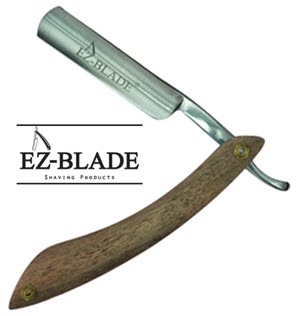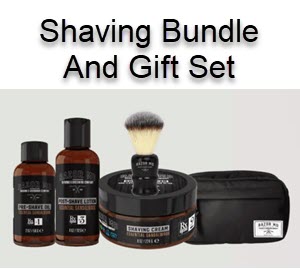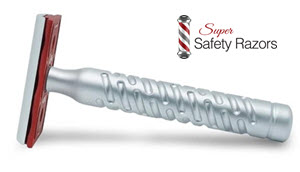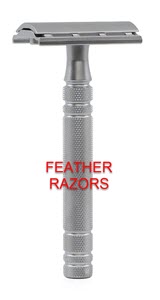Master the Art of Shaving: Your Guide to Buying a Straight Razor
The Art of Buying a Straight Razor: A Guide to Rediscovering Traditional Shaving
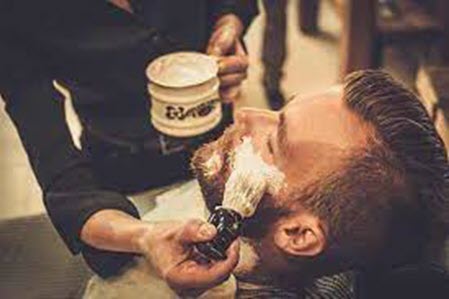
In the era of fast-paced innovation and disposable products, there’s a growing movement towards embracing the timeless and the traditional—particularly when it comes to personal grooming. With its storied history and unparalleled performance, the straight razor stands out as a symbol of this movement.
Suppose you’re considering purchasing a straight razor. In that case, you’re not just buying a tool but investing in an experience that combines skill, precision, and a touch of nostalgia. This article aims to guide you through the intent behind buying a straight razor and what to look for, ensuring your transition to traditional shaving is as smooth as the shave itself.
Understanding the Appeal
1. A Return to Tradition: There’s something inherently satisfying about engaging in a grooming ritual that has been practiced for centuries. Straight razor shaving is an art, a ritualistic experience that demands patience and skill, offering a moment of mindfulness in today’s rushed world.
- The Pursuit of Perfection: A straight razor’s precision and control allow for an exceptionally close shave. It glides over the skin, cutting each hair at the surface without tugging or pulling, reducing the risk of ingrown hairs and razor burn.
- Long-Term Savings and Sustainability: While the upfront cost of a quality straight razor can be higher than other shaving options, its longevity is unparalleled. With proper care, a straight razor can last a lifetime, negating the need for disposable blades and reducing waste, which is a win for your wallet and the planet.
- Mastering a Skill: Learning to shave with a straight razor is a rewarding challenge. It requires attention to detail, steady hands, and practice. You’ll enjoy better shaves and a sense of accomplishment as you improve.
Choosing Your Straight Razor
Material and Craftsmanship: Look for a razor made from high-quality steel, which ensures durability and a sharp edge. The handle (or scales) can be made from various materials, including wood, horn, or synthetic. The craftsmanship is critical, as a well-made razor will provide better balance and a more comfortable grip.
Blade Type: Straight razors come in different shapes and sizes, with varying types of points (round, square, etc.) and widths. Beginners might find a round point more manageable and easier to handle, while more experienced users may prefer the precision of a square point.
Maintenance Tools: To keep your razor in top condition, you’ll also need a strop for daily maintenance and a honing stone for occasional sharpening. Quality maintenance tools are as essential as the razor to ensure a sharp, smooth edge.
Embracing the Experience
Transitioning to a straight razor shave is about more than just the shave; it’s about embracing a piece of grooming history, learning a new skill, and taking a moment for yourself in a busy world. Whether the sustainability aspect attracts you, the quest for a closer shave, or the allure of mastering an ancient craft, buying a straight razor is a step towards a more mindful and satisfying grooming routine.
Remember, becoming proficient with a straight razor takes time and patience. Still, the rewards—both in terms of the quality of your shave and the satisfaction of the process—are unmatched. Welcome to the art of traditional shaving.
Comprehensive Guides on Selecting a Straight Razor
Choosing the right straight razor is a pivotal decision that can significantly enhance your shaving experience. This guide will delve into the essential factors you should consider, such as blade width, material, grind type, and point shape, to ensure your selection suits your skill level and shaving preferences.
Blade Width
The blade width of a straight razor is measured in increments of 1/8 inch and typically ranges from 3/8 inch to 8/8 inch. The width affects the razor’s maneuverability and the ease of reaching tight areas.
- Narrow Blades (3/8 inch to 5/8 inch): Ideal for beginners or those with finer facial hair. Narrower blades offer better visibility of the shaving area and easier maneuvering around the face and neck contours.
- Wider Blades (6/8 to 8/8 inch): For experienced users with coarse or dense facial hair. Wider blades hold more heat (from hot water application), providing a more comfortable shave, and can mow through thick beards more efficiently.
Material
The material of the blade affects its longevity, sharpness, and maintenance requirements.
- Carbon Steel is known for its ability to hold a very sharp edge and ease of sharpening. However, it requires more maintenance to prevent rust and corrosion.
- Stainless Steel offers excellent resistance to rust and corrosion, making it a more low-maintenance option. However, it may not hold an edge like carbon steel and can be harder to sharpen.
Grind Type
The grind of a straight razor blade refers to how the blade’s cross-section is shaped. It influences the blade’s flexibility and shaving feel.
- Full Hollow Grind: This grind features a skinny, highly flexible blade that provides a very close shave. It’s preferred by experienced users who appreciate a blade that conforms closely to the skin’s surface.
- Half or Quarter Hollow Grind: It balances flexibility and rigidity, suitable for those still refining their technique.
- Wedge or Near-Wedge Grind: This grind has the least concave grinding, resulting in a stiffer blade. It’s ideal for those with heavier beard growth or prefer a blade with more heft.
Point Shape
The shape of the blade’s point can affect the precision of the shave and the ease of handling.
- Round Point: Features a semi-circular end, making it less likely to nick the skin. It’s recommended for beginners because of its forgiving nature.
- Square Point: This tool has a sharp, straight point excellent for precise detailing, such as shaping sideburns or a mustache. It is best suited for experienced users.
- French Point: This point is characterized by a quarter-circle cut-out on the back, compromising a square point’s precision and a round point’s safety.
Tailoring to Skill Level and Preferences
- Beginners: You should opt for a razor with a narrow to medium width (5/8 inch), a round point, and a full or half hollow grind. These features make the razor easier to handle and reduce the risk of cuts.
- Intermediate to Experienced Users: Can explore wider blades, different point shapes like square or French points, and various grind types to find what best suits their technique and beard type.
Selecting the right straight razor is a nuanced process that should be approached with careful consideration of your personal needs, skill level, and shaving habits. Understanding these key factors will help you make an informed choice and ensure a satisfying and practical traditional shaving experience.
Maintenance and Care of a Straight Razor
Proper maintenance and care are crucial for preserving the performance and longevity of your straight razor. A well-maintained razor ensures a smooth, close shave every time and prevents rust and deterioration. Here’s a comprehensive guide on cleaning, drying, stooping, and honing your straight razor effectively.
Cleaning
After every shave, cleaning your razor thoroughly to remove hair, skin, and soap residue is essential.
- Rinse with Warm Water: Immediately after use, rinse the blade under warm water. It helps to remove most of the residue from the blade.
- Wipe the Blade: Carefully wipe the blade with a soft, dry cloth. Avoid using paper towels as they can leave fibers on the blade.
- Disinfect: Occasionally, it’s advisable to disinfect the blade using rubbing alcohol. Apply the alcohol to a cloth and gently wipe both sides of the blade. This step is crucial if you have sensitive skin or the razor is used sparingly.
Drying
Proper drying prevents rust and corrosion, significantly extending the life of your razor.
- Dry Thoroughly: Dry thoroughly after cleaning and disinfecting; dry the blade using a clean, soft cloth. Make sure to dry the pivot area where moisture can easily be trapped.
- Air Dry: Before storing, let the razor air dry entirely in an open space. It ensures any remaining moisture evaporates.
Stropping
Stropping aligns the blade’s edge before each shave, ensuring the razor is sharp and ready for use.
- Prepare the Strop: Hang your strop tightly without any slack. Leather on one side and canvas or linen on the other is typical. Start with the canvas side to warm up the blade.
- Stropping Technique: Hold the razor at about a 30-degree angle to the strop. Lead with the spine, flip the blade on its spine at the end of each stroke, and then come back in the opposite direction. It ensures the blade is aligned without dulling the edge. Perform 15-20 passes on the canvas and the leather side.
- Frequency: Strop your razor before each use to maintain optimal sharpness.
Honing
Honing is the blade’s sharpening and should be done every few months or when you notice the razor pulling on the hair instead of cutting cleanly.
- Choose the Right Hone: Use water or a honing stone with grit between 4000 and 8000 for regular maintenance. Higher grits can be used for finishing.
- Honing Technique: Wet the stone, place the blade flat against it with the edge facing forward, and gently push the blade across the stone, leading with the spine. Flip the blade over on its spine and repeat in the opposite direction. It usually requires 10-15 passes per side, varying depending on the blade’s condition.
- Testing Sharpness: You can carefully run the blade across a moistened thumbnail to test its sharpness. If it catches slightly, it’s sharp. Another method is the hanging hair test, in which a sharp blade should be able to cut through a hanging hair without significant force.
Preventing Rust
- Oil the Blade: If you plan not to use the razor for an extended period, apply a thin layer of light oil to protect the blade from moisture and prevent rust.
- Store Properly: Store your razor in a well ventilated area. Avoid bathrooms with high humidity, as this can promote rust.
Maintaining a straight razor requires a commitment to regular care, but the reward is a lifetime of superior shaves. Following these cleaning, drying, stropping, and honing guidelines ensures your razor remains sharp, rust-free, and ready for the perfect shave.
Shaving Techniques and Tips with a Straight Razor
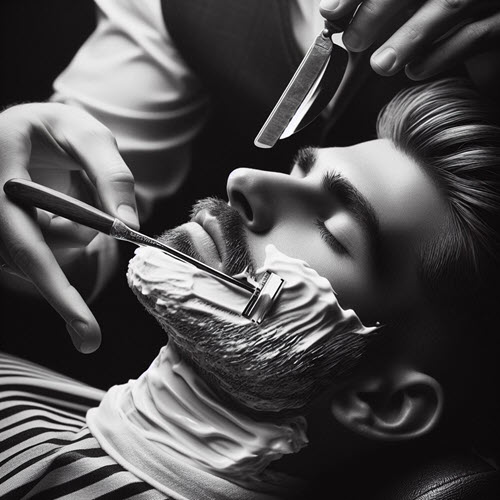
Shaving with a straight razor is both an art and a science. It requires technique, patience, and practice to achieve a close, comfortable shave without irritation. Here’s a detailed guide on preparing your skin, creating the perfect lather, holding the razor correctly, and executing the shave for optimal results.
Preparing Your Skin
Proper preparation is critical to softening your beard and reducing the risk of irritation and nicks.
- Hydrate: Begin by washing your face with warm water or a hot shower. This will soften the beard hair and open up the pores.
- Exfoliate: Use a gentle exfoliating scrub to remove dead skin cells, which can cause ingrown hairs. This step also raises the hair, making it easier to cut.
- Pre-Shave Oil: Apply pre-shave oil to soften the hair further and add a layer of protection between your skin and the blade.
Creating the Perfect Lather
A rich, protective lather is crucial for a smooth glide and effective shave.
- Selecting Shaving Cream or Soap: Choose a high-quality shaving cream or soap that provides good cushion and glide. Natural ingredients can help to moisturize and soothe the skin.
- Using a Shaving Brush: Wet your shaving brush with warm water and shake off the excess. Swirl the brush in the shaving cream or soap until you have a rich, creamy lather.
- Applying the Lather: Use the brush to apply the lather to your face in a circular motion. It lifts the hair and coats each strand thoroughly, ensuring a smooth shave.
Holding the Razor
The grip and angle at which you hold the razor are critical for control and effectiveness.
- The Proper Grip: Hold the razor with your index, middle, and ring finger on the back of the blade, your thumb near the middle on one side, and your pinky on the tang (the extension at the end of the handle). This grip offers stability and control.
- Blade Angle: Aim for a 30-degree angle between the blade and your skin. Too steep an angle increases the risk of cuts, while too shallow an angle will tug at the hair rather than cutting it.
Executing the Shave
The technique for the actual shave is where skill and practice come into play.
- Skin Stretching: Use your free hand to stretch the skin tight in the shaving area. It provides a flat surface for the razor and prevents nicks.
- First Pass: Start with the grain of your beard (the direction the hair grows). Use short, light strokes without applying too much pressure. Let the weight of the razor do the work.
- Second Pass (Optional): You can do a second pass across or against the grain for an even closer shave. Re-lather before each pass.
- Aftercare: Rinse your face with cold water to close the pores. Apply an aftershave balm or lotion to soothe and moisturize the skin.
Additional Tips
- Practice: Begin by shaving less sensitive areas like your cheeks before moving to more challenging areas like the neck and jawline.
- Maintenance: Keep your razor sharp with regular stropping and periodic honing. A sharp blade is essential for a smooth shave.
- Patience: Take your time, especially when you’re learning. Rushing increases the risk of cuts and irritation.
Mastering the straight razor shave is a rewarding journey that leads to unparalleled shaves and a deep sense of satisfaction. You can achieve a close, comfortable shave every time by preparing your skin correctly, creating a protective lather, holding the razor with precision, and shaving with care. Remember, practice makes perfect, and patience is vital to developing your technique.
Accessories and Complementary Products for Straight Razor Shaving
Straight razor shaving is not just about the razor itself; the accessories and complementary products are crucial in enhancing the shaving experience, ensuring a smooth shave, and maintahttps://amzn.to/49dZo0Kining the razor’s condition. Here’s a detailed overview of the essential and optional accessories for straight razor shaving, including tips on selecting and using them.
Strops
Purpose: A strop is used to align the fine edge of the razor blade before each shave, keeping it sharp and ensuring a smooth shave.
Selection: Look for a strop of high-quality leather for the best results. It should be long and wide enough to accommodate the entire length of your blade without needing to be moved during the stropping process. Many strops come with a secondary canvas or linen side, used before the leather to warm up the blade.
Use: Hold the strop taut and run the razor along it, leading with the spine and flipping the blade on its spine at the end of each stroke. Perform about 15-20 passes on each side before shaving.
Honing Stones
Purpose: Honing stones, or whetstones, are used to sharpen the razor’s edge when it becomes dull, typically every few months, depending on use.
Selection: Choose a honing stone with a grit suitable for your needs: a lower grit (4000-6000) for sharpening a dull blade and a higher grit (8000-12000) for refining and polishing the edge.
Use: Wet the stone, place the blade flat against its surface, and gently push the razor across the stone, leading with the spine. Flip the blade over and repeat. The number of passes depends on the blade’s condition and the stone’s grit.
Shaving Soaps and Creams
Purpose: These products help to lubricate and protect the skin during shaving, reducing irritation and making the shave smoother.
Selection: Opt for products made with natural ingredients that offer good cushioning and lubrication. Your choice between soap and cream can depend on personal preference; soaps tend to last longer and are more economical, while creams are more accessible to lather, especially for beginners.
Use a damp shaving brush to work up a rich lather in a bowl or directly on your face.
Shaving Brushes
Purpose: A shaving brush lifts facial hair and evenly distributes the shaving cream or soap, creating a rich lather and exfoliating the skin.
Selection: Brushes are made from various materials, including badger, boar, horsehair, and synthetic fibers. Badger hair is highly prized for holding water and creating a rich lather. Still, synthetic brushes offer a good, more affordable alternative.
Use: Soak the brush in warm water, shake off the excess, then swirl it in your shaving soap or cream until a lather forms. Apply to your face in circular motions.
Aftershave Treatments
Purpose: Aftershave helps to soothe, moisturize, and disinfect the skin after shaving, reducing irritation and preventing infection.
Selection: Choose an aftershave that matches your skin type. Products with natural ingredients and without alcohol are generally better for sensitive skin, as alcohol can dry out and irritate the skin.
Use: After rinsing your face with cold water to close the pores, apply a small amount of aftershave to your skin. Gently massage it in for maximum absorption.
Optional Accessories
- Shaving Bowl or Mug: Used to create lather with shaving soap. Some prefer to lather directly on the face, but a bowl can make the process easier and more enjoyable.
- Razor Stand: A stand helps to keep your razor and brush dry and in good condition by ensuring proper air circulation.
- Travel Case: For those who shave with a straight razor on the go, a travel case protects the razor and makes it convenient to carry.
The right accessories and complementary products can significantly enhance the straight razor shaving experience, from preparation to the final touch of aftershave. By selecting quality products suited to your needs and learning how to use them correctly, you can achieve a close, comfortable shave while maintaining your razor in top condition for years.
Workshops and Classes on Straight Razor Shaving
For those new to straight razor shaving, workshops and classes offer invaluable hands-on experience and guidance from seasoned professionals. These educational sessions can significantly shorten the learning curve, ensuring beginners start with the proper techniques and safety measures. Here’s what to know about finding and participating in these learning opportunities.
Types of Workshops and Classes
Local Barbershops and Salons: Many traditional barbershops and grooming salons offer workshops, or one-on-one sessions focused on straight razor shaving. These are typically led by experienced barbers who have mastered the craft and can provide personalized guidance.
Online Courses and Tutorials: For those who prefer learning at their own pace or cannot find local options, online platforms offer a range of courses and video tutorials. These can range from free YouTube instructional videos to more structured courses on educational platforms.
Shaving Clubs and Societies: Joining a shaving club or society can provide access to exclusive workshops, meet-ups, and seminars. Seasoned shaving enthusiasts often lead these gatherings and offer a community aspect to the learning experience.
What to Look For
Experienced Instructors: Whether choosing a local workshop or an online course, ensure the instructor has a solid traditional shaving and teaching background. Experienced barbers or long-time enthusiasts can provide insights not found in manuals or guides.
Comprehensive Curriculum: The class should cover all aspects of straight razor shaving, including:
- Pre-shave preparation (skin and beard)
- Selection and care of the razor
- Proper stropping and honing techniques
- Shaving techniques, including how to hold the razor and the angles for shaving
- Post-shave care and maintenance of the razor
Hands-On Practice: In physical workshops, hands-on practice should be allowed, ideally with the instructor providing real-time feedback. This practical experience is invaluable for building confidence and skill.
Safety Measures: A good course will emphasize safety, teaching how to minimize cuts and irritation. It includes handling the razor, skin stretching techniques, and first aid for nicks or cuts.
Finding Workshops and Classes
Search Locally: Check with local barbershops and grooming salons. Many may offer workshops or can recommend resources. Community centers or adult education programs also host classes.
Online Platforms: Websites like Udemy, Skillshare, and YouTube host various shaving courses and tutorials. Look for highly rated and reviewed content.
Social Media and Forums: Platforms like Reddit, Facebook, and shaving-specific forums can be excellent resources for finding recommendations on workshops and online courses. Members often share experiences and can offer tips on where to find the best instruction.
Shaving Clubs and Societies: Investigate whether there are any shaving clubs or societies in your area or online. These groups often organize educational events and are a great way to connect with fellow enthusiasts.
Benefits of Participating
Participating in workshops and classes accelerates your learning and connects you with a community of like-minded individuals. It provides a foundation of good habits, techniques, and safety practices that ensure a lifetime of enjoyable and effective straight razor shaving. Additionally, these sessions can offer insights into the broader culture of traditional shaving, including the history and craftsmanship behind the tools and techniques.
Conclusion
For beginners, workshops and classes on straight razor shaving are invaluable resources for mastering the art and craft of this traditional grooming method. By learning from experienced barbers or enthusiasts, you can quickly gain the skills and confidence needed for a close, comfortable shave while avoiding common pitfalls. Whether through local barbershops, online courses, or shaving communities, a wealth of knowledge is waiting to be explored.
- Bakblade 2.0: The Best Back Shaver for Men
- Ball Shaver That Won’t Cut You
- Shaving Gel: What to Know About!
- Henson Shaving: Where Design Meets Durability and Performance
- Caramel Honey Blonde Hair: Elevate Your Look
- Feather Razors: Precision Shaving for Every Skin Type
- Straight Razor Shaving: Unlocking a Closer, Smoother Shave
- Premium Safety Razors: Your Guide to Quality Shave
- Pros & Cons: Shaving Against the Grain Guide
- Maximize Your Shave: Norelco Sensotouch 3d Razor
